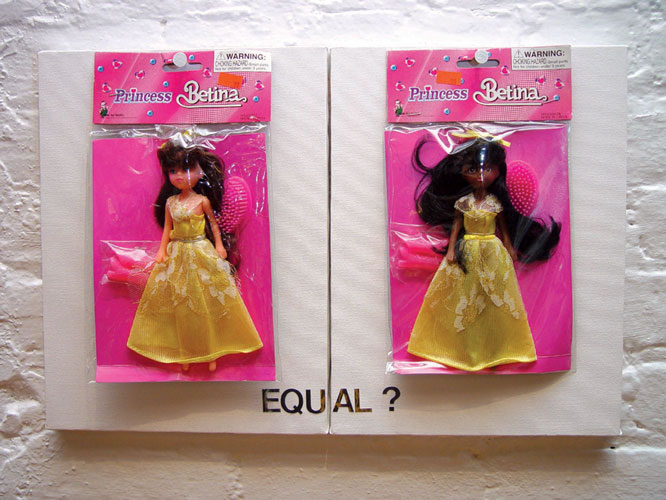'EQUAL'
Size: H 12’’x L 18’’. (31cm x 46 cm) Princess dolls under plastic wrap.
Origin: 99c store, Manhattan.
“Toys represent fundamental ideas, desires, and concerns that are central to the lives of people and culture”. Quiao Shouning (Professor at Shanxi University).
-’’Mattel’s first black doll, ‘Colored Francie’; was introduced in 1967. She was available in one color and was literally formed in the same mold as the white barbies on the shelf.
-1980s the toy industry’s leading manufacturers, Mattel, Hasbro, and Tyco, began to introduce ‘ethnically correct’ dolls and toys. Mattel, for instance, introduced its Shani line, three African American dolls, each with a slightly different skin tone and with newly sculpted faces. These faces were purportedly more realistic in their representations of black features than those of other dolls. These ethnically - correct toys were not a new idea: minority- owned toy companies had been making such dolls for over twenty years. Early manufacturers of ethnically - correct dolls such as Olmec or
Shindana had a focused social and political agenda aimed at undermining the racism endemic to an industry that seemed to believe that all baby dolls and barbies - (and, by implication, people) - ought to be white.
- In the 1990s, however, this agenda seemed to have its greatest potential in its ability to generate profit rather than social change” (“Purchasing power”, Elisabeth Chin, Associate Professor of Anthropology at Occidental College, LA) African American buying power (after taxes) 2002: $645 BILLION @ Strategic Buzz. Africain Americain buying power (after taxes) by 2007: $ 852,8 BILLION @ Strategic Buzz.

